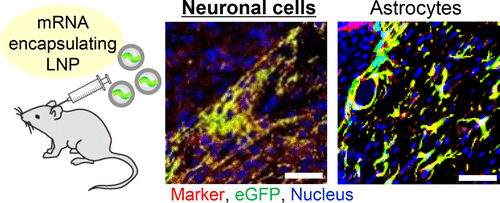当前位置:
X-MOL 学术
›
Mol. Pharmaceutics
›
论文详情
Our official English website, www.x-mol.net, welcomes your
feedback! (Note: you will need to create a separate account there.)
In Vivo Introduction of mRNA Encapsulated in Lipid Nanoparticles to Brain Neuronal Cells and Astrocytes via Intracerebroventricular Administration
Molecular Pharmaceutics ( IF 4.5 ) Pub Date : 2018-04-11 00:00:00 , DOI: 10.1021/acs.molpharmaceut.7b01084 Hiroki Tanaka 1 , Taichi Nakatani 2 , Tomomi Furihata 3 , Kota Tange 4 , Yuta Nakai 4 , Hiroki Yoshioka 4 , Hideyoshi Harashima 2 , Hidetaka Akita 1
Molecular Pharmaceutics ( IF 4.5 ) Pub Date : 2018-04-11 00:00:00 , DOI: 10.1021/acs.molpharmaceut.7b01084 Hiroki Tanaka 1 , Taichi Nakatani 2 , Tomomi Furihata 3 , Kota Tange 4 , Yuta Nakai 4 , Hiroki Yoshioka 4 , Hideyoshi Harashima 2 , Hidetaka Akita 1
Affiliation

|
Gene therapy is a promising strategy for curing certain types of brain diseases. Supplementation of therapeutic proteins such as aromatic amino acid decarboxylase (AADC) or nerve growth factor (NGF) have been reported to be successful examples of such treatments. However, there are safety concerns because these systems are based on virus-based gene vectors. A safe and efficient artificial carrier is thus urgently needed as an alternative. In this study, an mRNA based artificial gene carrier was introduced into the mouse brain via intracerebroventricular administration. As a carrier, a lipid nanoparticle (LNP) composed of environmentally sensitive lipid-like materials called an SS-cleavable proton-activated lipid-like material is used. The apolipoprotein E mediated cellular uptake of the lipid nanoparticles is one of the key features for its superior and homogeneous transfection activity compared to commercially available transfection reagents in both in vitro and in vivo situations. Immunostaining of brain specimens suggested that exogenous proteins can be introduced into neuronal cells as well as astrocytes using the mRNA-based gene carrier. This cannot be achieved using DNA-based artificial gene carriers. The findings suggest that a combination of an mRNA and a lipid based delivery system have great promise as a platform for the treatment of brain disorders.
中文翻译:

体内通过脑室内给药将脂质纳米颗粒中封装的mRNA引入脑神经元细胞和星形胶质细胞。
基因疗法是治疗某些类型的脑部疾病的有前途的策略。据报道,补充治疗性蛋白质如芳香族氨基酸脱羧酶(AADC)或神经生长因子(NGF)是此类治疗的成功例子。但是,由于这些系统基于基于病毒的基因载体,因此存在安全隐患。因此,迫切需要一种安全有效的人工载体。在这项研究中,通过脑室内给药将基于mRNA的人工基因载体引入小鼠大脑。作为载体,使用由对环境敏感的类脂质材料(称为SS可裂解的质子活化的类脂质材料)组成的类脂质纳米颗粒(LNP)。载脂蛋白E介导的脂质纳米颗粒对细胞的摄取是其在体外和体内情况下均比市售转染试剂优越和均匀转染活性的关键特征之一。脑标本的免疫染色表明,可以使用基于mRNA的基因载体将外源蛋白引入神经元细胞和星形胶质细胞。使用基于DNA的人工基因载体无法实现这一点。这些发现表明,mRNA和基于脂质的输送系统的结合有望作为治疗脑部疾病的平台。脑标本的免疫染色表明,可以使用基于mRNA的基因载体将外源蛋白引入神经元细胞和星形胶质细胞。使用基于DNA的人工基因载体无法实现这一点。这些发现表明,mRNA和基于脂质的输送系统的结合有望作为治疗脑部疾病的平台。脑标本的免疫染色表明,可以使用基于mRNA的基因载体将外源蛋白引入神经元细胞和星形胶质细胞。使用基于DNA的人工基因载体无法实现这一点。这些发现表明,mRNA和基于脂质的输送系统的结合有望作为治疗脑部疾病的平台。
更新日期:2018-04-11
中文翻译:

体内通过脑室内给药将脂质纳米颗粒中封装的mRNA引入脑神经元细胞和星形胶质细胞。
基因疗法是治疗某些类型的脑部疾病的有前途的策略。据报道,补充治疗性蛋白质如芳香族氨基酸脱羧酶(AADC)或神经生长因子(NGF)是此类治疗的成功例子。但是,由于这些系统基于基于病毒的基因载体,因此存在安全隐患。因此,迫切需要一种安全有效的人工载体。在这项研究中,通过脑室内给药将基于mRNA的人工基因载体引入小鼠大脑。作为载体,使用由对环境敏感的类脂质材料(称为SS可裂解的质子活化的类脂质材料)组成的类脂质纳米颗粒(LNP)。载脂蛋白E介导的脂质纳米颗粒对细胞的摄取是其在体外和体内情况下均比市售转染试剂优越和均匀转染活性的关键特征之一。脑标本的免疫染色表明,可以使用基于mRNA的基因载体将外源蛋白引入神经元细胞和星形胶质细胞。使用基于DNA的人工基因载体无法实现这一点。这些发现表明,mRNA和基于脂质的输送系统的结合有望作为治疗脑部疾病的平台。脑标本的免疫染色表明,可以使用基于mRNA的基因载体将外源蛋白引入神经元细胞和星形胶质细胞。使用基于DNA的人工基因载体无法实现这一点。这些发现表明,mRNA和基于脂质的输送系统的结合有望作为治疗脑部疾病的平台。脑标本的免疫染色表明,可以使用基于mRNA的基因载体将外源蛋白引入神经元细胞和星形胶质细胞。使用基于DNA的人工基因载体无法实现这一点。这些发现表明,mRNA和基于脂质的输送系统的结合有望作为治疗脑部疾病的平台。










































 京公网安备 11010802027423号
京公网安备 11010802027423号